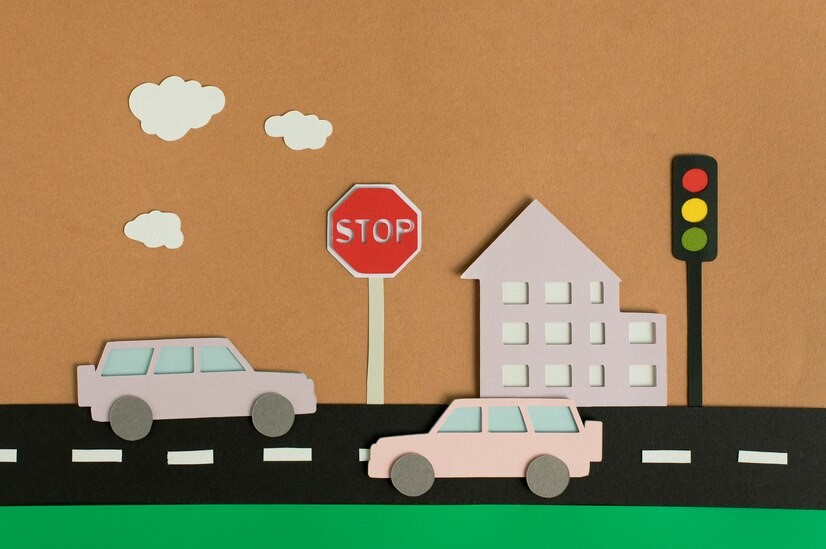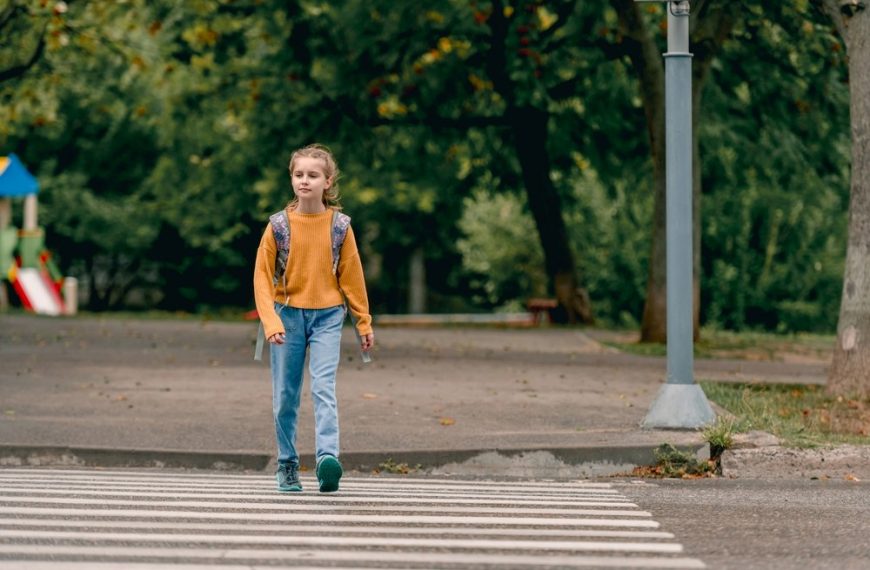India has a huge population resulting in a large number of automobiles. In our country, traffic safety is a top concern, particularly for kids. According to a report by the Save Life Foundation, in 2019, around 9,305 children lost their lives in road accidents across the nation. This alarming statistic highlights the critical need for educating our kids on road safety rules and practices.
Road safety is an essential skill that our children need to learn early on. They must know how to navigate the streets with confidence and caution.
This blog post will delve into the top 10 road safety rules your kids should know. We’ll also touch upon road signs for kids, tips for road safety, and traffic signs for kids. So buckle up and let’s dive into this perplexing and bursting topic!
Understand the significance of traffic lights
Traffic lights are among the most crucial traffic signs for kids to recognize. These lights manage traffic flow and ensure safe crossing for pedestrians. Teach your children the meaning of each colour:
Red: Stop
Green: Go
Yellow: Slow down or prepare to stop
Additionally, emphasise that obeying traffic lights is not just about personal safety, but also about respecting the safety of others on the road. Encourage them to always wait patiently at the red light and not rush the moment it turns green, to ensure a safe crossing.
Traffic Rules for Kids

Pedestrian crossings are marked areas on the roads where people can cross safely. Inform your kids about the different types of pedestrian crossings like zebra, pelican, and puffin crossings. Explain that they should always use these designated areas to cross the road and never jaywalk.
One of the basics of teaching traffic rules for kids is to make them aware of their surroundings. Stress the importance of making eye contact with drivers before crossing, ensuring they are seen, and reminding them to never assume a car will stop, highlighting the need for constant vigilance even in safe crossing zones.
Look left, right, and left again before crossing
One of the fundamental tips for road safety is to look both ways before crossing the road. Kids should look left, then right, and left again to ensure that no vehicles are approaching. This rule applies even when using pedestrian crossings, as drivers may not always follow traffic rules.
Teach them to not just look but also listen for oncoming traffic, especially electric vehicles that may be quieter, and to never cross while distracted, for example, by looking at a mobile phone.
Hold hands with an adult while crossing the road
Young children should always hold hands with a responsible adult when crossing the road. This practice ensures that they are safe and guided by someone who understands traffic rules and can react to sudden changes in traffic conditions.
Reinforce the idea that holding hands is a part of staying safe and that they should do so until they are old enough to understand and judge the safety of crossing roads independently.
Road Safety for Kindergarten
Inculcating in your offspring a comprehensive understanding of a plethora of road signs for kindergarten, comprising but not limited to stop signs, speed limit signs, and pedestrian crossing signs, can play an instrumental role in augmenting their situational awareness and fostering a keen sense of accountability when navigating the thoroughfare.
Encourage your children to ask questions about any road safety for kindergarten they do not understand, fostering curiosity and eagerness to learn about road safety from an early age.
Road Safety for Preschoolers
We’d like to share some fundamental road safety lessons and how to incorporate them into enjoyable games that your youngster will enjoy.
Know Your Signals
Stop signs are among the first things you can teach your child. Knowing that when they see one at a crosswalk, they stop instantly, and that motorists must stop when they see one is extremely crucial. The same is true for stop lights, where green signifies go, yellow means slow, and red means stop. Knowing signals is important for the safety of preschoolers.
Stop, look, and listen.
When crossing the street, your child must understand the need to stop, look both ways and listen for oncoming traffic.
Learning to use the crosswalk
The crosswalk can be intimidating for both youngsters and parents who are concerned that their children will forget their safety training. Fortunately, they already understand how to come to a complete halt, look, and listen. The crosswalk is a part of road safety for preschoolers.
Wear bright clothing and reflective gear
Kids should wear bright clothing and reflective gear, especially when walking or biking near roads. This tip for road safety for kindergarten is essential because it makes them more visible to drivers, reducing the risk of accidents.
Explain the science behind reflective materials and how they catch a driver’s attention, making it an interesting and educational topic that highlights the importance of being seen.
Use sidewalks and footpaths
Encourage your children to use sidewalks and footpaths whenever available. Walking on the road itself is dangerous and should be avoided. If there is no sidewalk or footpath, they should walk facing traffic so they can see oncoming vehicles and react accordingly.
Discuss the added safety benefits of walking in areas designated for pedestrians and the dangers of straying onto the road, emphasising the importance of staying within safe boundaries.
Do not play near roads
Playing near roads can be hazardous, as children may unknowingly run onto the road and put themselves in danger. Tell your children to only play in secure public spaces, like schools or parks, and to stay away from busy streets.
Use real-life examples of safe play areas versus dangerous ones to help them understand the difference, reinforcing the concept through repetition and positive reinforcement.
Understand the importance of traffic signs for kids
Traffic signs for kids are crucial in ensuring their safety on the road. Teach your kids how to read and obey road signals, like yield signs, stop signs, and traffic indication lamps. Understanding these signs will help them navigate the streets safely and responsibly.
Involve them in interactive games that reinforce their knowledge of traffic signs, making learning both fun and memorable, ensuring they remember these signs when they’re out and about.
Learn and follow the safe biking rules
If your child rides a bicycle, they must learn and follow safe biking rules. Some key guidelines include:
Wearing a helmet
Using hand signals to indicate turns
Following traffic rules and signs
Riding in the same way as the traffic on the right side of the road safety
In addition to these rules, stress the importance of maintaining their bike in good working order, checking brakes, and lights regularly, and remind them that biking safely is part of being a responsible cyclist and member of the community.
Conclusion
In conclusion, road safety rules are a perplexing and bursting topic that every parent and guardian should prioritise. By imparting to your child the crucial 10 commandments of the road, you are arming them with the indispensable savoir-faire required to circumvent any potential hazards that may lurk ahead. It is vital to bear in mind that rote memorization alone won’t suffice; it is imperative to instil within your offspring a strong sense of accountability and attentiveness, empowering them to navigate the terrain with aplomb.
To recap, some of the primary road safety for kids include understanding traffic lights, using pedestrian crossings, looking both ways before crossing, holding hands with an adult, being aware of road signs, wearing bright clothing and reflective gear, using sidewalks and footpaths, avoiding play near roads, recognizing traffic signs, and following safe biking rules.
Moreover, as parents and guardians, it’s crucial to set a good example by following these road safety rules and tips yourself. Children often learn by example, so make sure you practise what you preach. This approach will help reinforce the importance of road safety and create a safer environment for everyone.
Additionally, take the time to discuss road safety with your children regularly, and ensure they have a clear understanding of the rules. Encourage them to ask questions and clarify any doubts they may have. This open communication will help build their confidence and empower them to make smart decisions when navigating the streets.
Finally, remember that road safety is an ongoing learning process. As your children grow older and become more independent, continue to reinforce these road safety rules and encourage them to practise caution and mindfulness on the roads. By instilling these values early on, you’re setting them up for a lifetime of safe and responsible road habits.
So, parents and guardians, let’s unite and take on this perplexing and bursting challenge of road safety for kids. Together, we can make the world safer for our kids and ensure that they develop the information and abilities necessary to safely and boldly traverse the streets. Happy road safety learning!
At EuroKids, we understand the importance of safety when it comes to our children. Our preschool network is India’s first safe school network.
To know more about us and our carefully curated curriculum, visit the nearest EuroKids centre today!
For informative and accurate articles on all things related to your new born-toddler’s development, growth, health and nutrition, follow EuroKids Blogs and do check out our nationally recognized preschools – EuroKids for the first step in your kid’s educational journey!
FAQs:
Q1: Why is it important for kids to learn road safety rules?
Learning road safety rules is crucial for kids to navigate streets safely, avoid accidents, and develop responsible habits that will protect them and others on the road.
Q2: At what age should children start learning about road safety?
Children can start learning basic road safety rules as early as preschool age. As they grow, more complex rules can be introduced.
Q3: How can parents encourage their children to follow road safety rules?
Parents can encourage their children by setting a good example, discussing road safety regularly, making learning interactive with games and activities, and reinforcing the importance of these rules.
Q4: Are there specific road signs that kids should be familiar with?
Yes, kids should be familiar with basic road signs such as stop signs, pedestrian crossing signs, traffic lights, and speed limit signs. Understanding these helps in making informed decisions while on the road.
Q5: How can kids stay safe while riding a bicycle?
Kids can stay safe by wearing a helmet, using hand signals, following traffic rules and signs, and riding on the right side of the road in the same direction as traffic.
Q6: What role do schools play in teaching road safety?
Schools play a vital role by incorporating road safety education into their curriculum, organizing interactive sessions, and sometimes partnering with local traffic police to give practical demonstrations.
Q7: Can playing near roads be safe under any circumstances?
It is generally unsafe for children to play near roads due to the risk of accidents. Safe play areas are designated spaces like parks or playgrounds away from traffic.
Q8: How can reflective gear help in road safety for kids?
Reflective gear makes children more visible to drivers, especially during low light conditions, reducing the likelihood of accidents.
Q9: What should children do if there are no sidewalks or pedestrian crossings available?
If no sidewalks are available, children should walk facing traffic on the side of the road to see oncoming vehicles. Without pedestrian crossings, they should be extra cautious and only cross when it’s safe, ideally at a well-visible spot.
Q10: How can road safety lessons be made engaging for kids?
Road safety lessons can be made engaging through interactive games, storytelling, role-playing, and educational videos and apps designed to teach road safety enjoyably.















